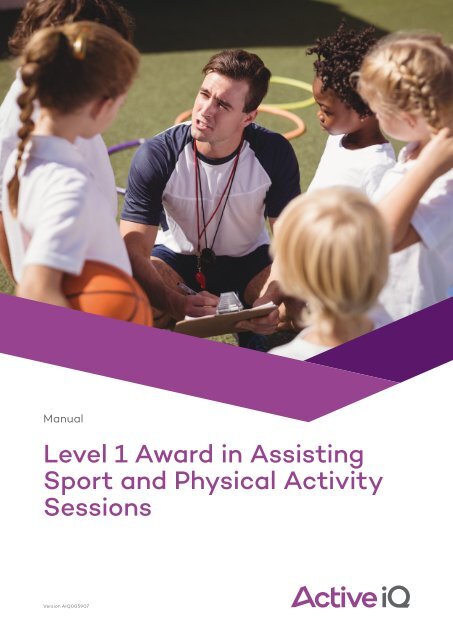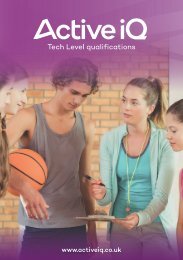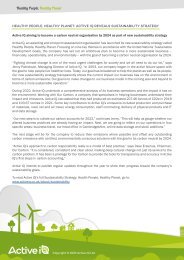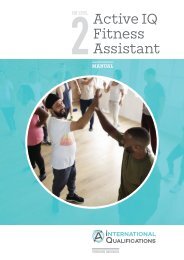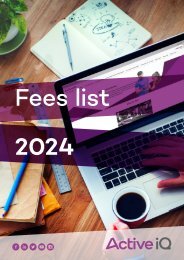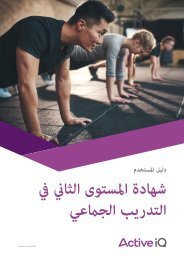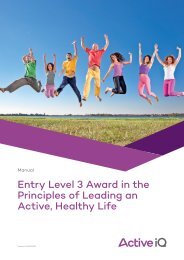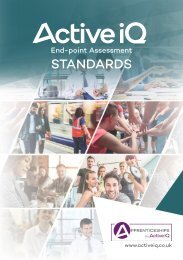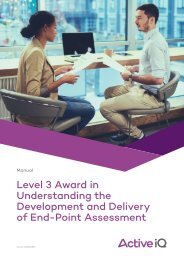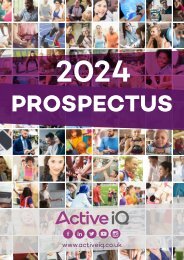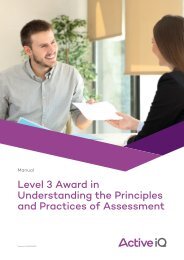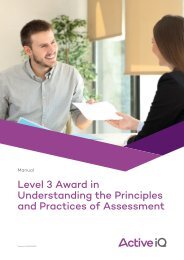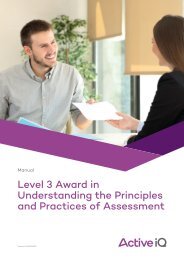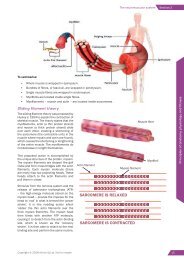Level 1 Award in Assisting Sport and Physical Activity Sessions (sample manual)
- No tags were found...
Create successful ePaper yourself
Turn your PDF publications into a flip-book with our unique Google optimized e-Paper software.
Manual<br />
<strong>Level</strong> 1 <strong>Award</strong> <strong>in</strong> Assist<strong>in</strong>g<br />
<strong>Sport</strong> <strong>and</strong> <strong>Physical</strong> <strong>Activity</strong><br />
<strong>Sessions</strong><br />
Version AIQ005907
Section 1<br />
Health <strong>and</strong> safety considerations for sport <strong>and</strong> physical activity<br />
Stretch<strong>in</strong>g<br />
Previously we def<strong>in</strong>ed the types of stretch<strong>in</strong>g used <strong>in</strong> sport <strong>and</strong> physical activity; take a look at some of the<br />
advantages <strong>and</strong> disadvantages of static <strong>and</strong> dynamic stretch<strong>in</strong>g below.<br />
Static stretch<strong>in</strong>g: helps to rehabilitate <strong>in</strong>juries, improves range of motion of jo<strong>in</strong>ts <strong>and</strong> ma<strong>in</strong>ta<strong>in</strong>s<br />
mobility, <strong>in</strong>creases blood flow to muscles, encourages relaxation post-activity.<br />
Dynamic stretch<strong>in</strong>g: warms up core muscle temperature, mobiilsation of jo<strong>in</strong>ts <strong>and</strong> movement<br />
preparation for activity. Prepares body specifically for activity, reduces risk of <strong>in</strong>jury, more<br />
explosive power. Mentally prepares body for moderate–vigorous activity ahead.<br />
Static stretch<strong>in</strong>g: is not good pre-exercise when the muscles are cold, can impair strength <strong>and</strong><br />
explosive power, needs to be used at the right time.<br />
Dynamic stretch<strong>in</strong>g: does not allow you to relax fully post-activity, may aggrevate <strong>in</strong>juries<br />
post-session.<br />
Choos<strong>in</strong>g activities for muscle balance<br />
Previously, <strong>in</strong> Unit 1, we discussed how muscles work <strong>in</strong><br />
pairs to create movement. One muscle contracts <strong>and</strong><br />
pulls on the bones to br<strong>in</strong>g about movement, while the<br />
opposite muscle relaxes to allow the movement. This<br />
happens cont<strong>in</strong>uously whenever the body is mov<strong>in</strong>g.<br />
When one muscle is stronger than its oppos<strong>in</strong>g<br />
muscle, there will be an imbalance. For <strong>in</strong>stance, if you<br />
do leg extensions daily, but never do hamstr<strong>in</strong>g curls,<br />
there’s a good chance your quadriceps will be stronger<br />
than your hamstr<strong>in</strong>gs <strong>and</strong> it is likely that you will have<br />
a strength imbalance.<br />
Your oppos<strong>in</strong>g muscles <strong>and</strong> muscle groups are<br />
supposed to work together. Those muscles must be<br />
balanced <strong>in</strong> terms of strength, flexibility <strong>and</strong> even<br />
posture to be efficient <strong>and</strong> to prevent <strong>in</strong>juries.<br />
POINT OF<br />
INTEREST<br />
• Biceps + triceps = bend <strong>and</strong> straighten<br />
the elbows.<br />
• Deltoids + latissimus dorsi = lift <strong>and</strong><br />
lower the arms.<br />
• Abdom<strong>in</strong>als + erector sp<strong>in</strong>ae = bend<br />
the sp<strong>in</strong>e forwards <strong>and</strong> backwards.<br />
• Quadriceps + hamstr<strong>in</strong>gs = bend <strong>and</strong><br />
straighten the knee.<br />
• Hip abductors + adductors = move the<br />
legs towards each other or apart.<br />
8<br />
Copyright © 2018 Active IQ Ltd. Not for resale
Effective delivery of activity sessions<br />
Section 3<br />
Section 3: Effective delivery of<br />
activity sessions<br />
Successful sport <strong>and</strong> physical activity sessions always have clearly identified SMART aims <strong>and</strong> objectives so that<br />
the success of the activity can be measured <strong>and</strong> the progress of the participants achieved <strong>and</strong> developed.<br />
What can you remember from Unit 3? Complete the table below.<br />
Create a SMART objective for a sport or physical activity session<br />
Objective:<br />
What makes it<br />
specific?<br />
POINT OF<br />
INTEREST<br />
What makes it<br />
measurable?<br />
How do you know it<br />
is achievable?<br />
Eight benefits of goal-sett<strong>in</strong>g<br />
1. Clear focus on what you want to achieve.<br />
2. Optimise use of available resources.<br />
3. Effective use of time.<br />
4. Peace of m<strong>in</strong>d – gives perspective, commitment <strong>and</strong><br />
action.<br />
5. Easier decision-mak<strong>in</strong>g.<br />
6. Clear measurement of progress.<br />
7. Freedom of thought – look for ways to make it happen.<br />
8. Easier communication with others.<br />
(www.the-happy-manager.com)<br />
Types of equipment<br />
How do you know it<br />
is relevant?<br />
How do you know it<br />
is time-bound?<br />
When plann<strong>in</strong>g your session it is important to th<strong>in</strong>k about the types of equipment you might need <strong>and</strong> their purpose.<br />
Assist<strong>in</strong>g <strong>in</strong> the plann<strong>in</strong>g <strong>and</strong> delivery of a sport or physical activity session<br />
Safety<br />
Coach /<br />
leaders<br />
Equipment<br />
Participants<br />
Technical<br />
/ sportspecific<br />
Copyright © 2018 Active IQ Ltd. Not for resale 11
TOP<br />
TIPS<br />
for effective<br />
communication:<br />
HAZARDS<br />
IN A FITNESS<br />
ENVIRONMENT:<br />
Facilities<br />
Equipment<br />
1 Speak clearly.<br />
2 Keep it simple, stupid (KISS).<br />
3 Ensure that your participants can see <strong>and</strong> hear you.<br />
Work<strong>in</strong>g practices<br />
4 Say what you show: words should match actions.<br />
5 Use appropriate language for your<br />
participants’ age <strong>and</strong> underst<strong>and</strong><strong>in</strong>g.<br />
Clients<br />
6 Use question<strong>in</strong>g to check underst<strong>and</strong><strong>in</strong>g.<br />
7 Move around the area if easier<br />
to communicate this way.<br />
8 Use professional body language – st<strong>and</strong><br />
tall, don’t fold arms <strong>and</strong> don’t sit down.<br />
9 Be m<strong>in</strong>dful of noise <strong>and</strong> distractions.<br />
Client behaviour<br />
Security<br />
10 Project your voice.<br />
11 Use visual aids to assist you –<br />
whiteboards, clocks, signs.<br />
Hygiene<br />
12 Make eye contact<br />
Copyright © 2018 Active IQ Ltd. Not for resale
Active IQ<br />
Dryden House<br />
St. Johns Street<br />
Hunt<strong>in</strong>gdon<br />
PE29 3NU<br />
T 01480 467 950<br />
F 01480 456 283<br />
<strong>in</strong>fo@activeiq.co.uk<br />
www.activeiq.co.uk<br />
Active IQ wishes to emphasise that<br />
whilst every effort is made to ensure<br />
accuracy, the material conta<strong>in</strong>ed with<strong>in</strong><br />
this document is subject to alteration<br />
or amendment <strong>in</strong> terms of overall<br />
policy, f<strong>in</strong>ancial or other constra<strong>in</strong>ts.<br />
Reproduction of this publication is<br />
prohibited unless authorised by Active IQ<br />
Ltd. No part of this document should be<br />
published elsewhere or reproduced <strong>in</strong> any<br />
form without prior written permission.<br />
Copyright © 2020 Active IQ Ltd. Not for resale.


